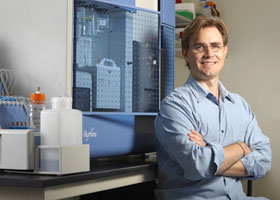Feature Story
Health Center Today, August 31, 2009
Illumina Genome Analyzer – Taking Genomic Research to the Next Level
By Jim H. Smith

Brenton Graveley and the Illumina Genome Analyzer.
Photo by Lanny Nagler
Two papers co-authored by Brenton Graveley and recently accepted for publication in the journals RNA and Cell are the first containing data generated by the Health Center’s powerful Illumina Genome Analyzer. Graveley, who oversees the Health Center’s Translational Genomics Core, predicts they are only the vanguard. That’s because the Illumina Sequencer, acquired little more than a year ago, has already been used by Graveley’s team to generate over 125 billion bases of sequence, more than 40 times the size of the human genome. And, he notes, “The output is increasing exponentially.”
Sequencers are optical instruments. They rapidly perform their task by analyzing light signals from fluorochromes, fluorescent dyes connected to the nucleotides of genetic samples during chemical reactions within the sequencer. Using optical detectors that identify the wavelengths at which the different dyes fluoresce, the sequencers swiftly zero in on the genes’ base combinations.
Another sequencer, manufactured by Branford-based 454 Life Sciences, is housed in the Department of Molecular and Cell Biology on the Storrs campus and operated under the direction of Rachel O’Neill and Linda Strausbaugh. While the two units are interfaced, each offers distinct advantages. “The 454 is useful for sequencing long strands of genetic material,” says Graveley. “The Illumina device can only generate shorter sequences, but can generate much more data than the 454.”
While the Illumina sequencer can process multiple batches of DNA in a single run, each experiment takes several days to complete. So many UConn scientists rely upon the machine that demand has already outstripped its capacity. Consequently, Storrs and the Health Center are teaming up to acquire a third unit.
Part of what has made the new sequencers so popular are scientific breakthroughs in the study of microRNAs and alternative splicing that have significantly changed the research picture in the nine years since the Human Genome Project was completed. “As recently as the late 1990s, it was thought that most human genes encoded only a single messenger RNA (mRNA) isoform,” says Graveley. “Now we know that alternative splicing is the rule, not the exception. In fact, 95 percent of human genes encode at least two isoforms and most known alternative-splicing events are regulated.”
Graveley and his team are currently working on one line of related research. They are one of six teams participating in a project called modENCODE, funded by the National Institutes of Health’s National Human Genome Research Institute. Researchers are trying to identify the myriad of alternative splicing pathways in the genomes of Drosophila melanogaster, the common fruit fly, and Caenorhabditis elegans, a tiny roundworm. “The Drosophila’s genome is very compact and only about one-tenth the size of the human genome,” Graveley says. “That makes it very useful for this research.”
Completing the project – which involves studying which genes are turned on and off at some 30 points over the course of the fly’s lifespan – is expected to take about two more years. Researchers expect to then know much more about how to study alternative splicing in the much more complex human genome. That task, elements of which have already begun, is projected to conclude in 2012.


